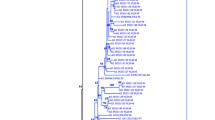Abstract
Human enterovirus 71 viruses have been long circulating throughout the world. In this study, we performed a positive selection analysis of the VP1 genes of capsid proteins from Enterovirus 71 viruses. Our results showed that although most sites were under negative or neutral evolution, four positions of the VP1 genes were under positive selection pressure. This might account for the spread and frequent outbreaks of the viruses and the enhanced neurovirulence. In particular, position 98 might be involved in neutralizing antibodies, modulating the virus-receptor interaction and enhancing the virulence of the viruses. Moreover, both positions 145 and 241 might correlate to determine the receptor specificity. However, these positions did not display much difference in amino acid polymorphism. In addition, no position in the VP1 genes of viruses isolated from China was under positive selection.
Similar content being viewed by others
References
Brown B A, Pallansch M A. 1995. Complete nucleotide sequence of enterovirus 71 is distinct from poliovirus. Virus Res, 39(2–3): 195–205.
Brown B A, Steven Oberste M, Alexander J P, et al. 1999. Molecular Epidemiology and Evolution of Enterovirus 71 Strains Isolated from 1970 to 1998. J Virol, 73(12): 9969–9975.
Bush R M, Fitch W M, Bender C A, et al. 1999. Positive selection on the H3 hemagglutinin gene of human influenza virus A. Mol Biol Evol, 16: 1457–1465.
Campitelli L, Ciccozzi M, Salemi M, et al. 2006. H5N1 influenza virus evolution: a comparison of different epidemics in birds and humans (1997-2004). J Gen Virol, 87: 955–960.
Cardosa M J, Krishnan S, Tio P H, et al. 1999. Isolation of subgenus B adenovirus during a fatal outbreak of enterovirus 71-associated hand, foot and mouth disease in Sibu, Sarawak. Lancet, 354: 987–991.
Cardosa M J, Perera D, Brown B A, et al. 2003. Molecular epidemiology of human enterovirus 71 strains and recent outbreaks in the Asia-Pacific region: comparative analysis of the VP1 and VP4 genes. Emerg Infect Dis, 9(4): 461–468.
Chan L G, Parashar U D, Lye M S, et al. 2000. Deaths of children duringan outbreak of hand, foot and mouth disease in Sarawak, Malaysia: clinical and pathological characteristics of the disease. Clin Infect Dis, 31: 678–683.
Chan Y F, AbuBaker S. 2004. Recombinant human enterovirus 71 in hand, foot and mouth disease patients. Emerg Infect Dis, 10(8): 1468–1470.
Dong X N, Ying J, Chen Y H. 2007. Molecular epidemiology and evolution of worldwide enterovirus 71 strains isolated from 1970 to 2004. Chin Sci Bull, 52(11):1484–1490
Fitch W M, Leiter J M E, Li X, et al. 1991. Positive Darwinian evolution in human influenza A viruses. Proc Natl Acad Sci USA, 88: 4270–4274.
Guindon S, Gascuel O. 2003. A simple, fast, and accurate algorithm to estimate large phylogenies by maximum likelihood. Syst Biol, 52: 696–704.
Ina Y, Gojobori T. 1994. Statistical analysis of nucleotide sequences of the hemagglutinin gene of human influenza A viruses. Proc Natl Acad Sci USA, 91: 8388–8392.
Kim S, Smith T J, Chapman M S, et al. 1989. Crystal structure of human rhinovirus serotype 1A (HRV1A). J Mol Biol, 210: 91–111.
Kosakovsky Pond S L, Frost S D W, Muse S V. 2005. HyPhy: hypothesis testing using phylogenies. Bioinformatics, 21: 676–679.
Lambert C, Leonard N, De Bolle X, et al. 2002. ESyPred3D: Prediction of proteins 3D structures. Bioinformatics, 18: 1250–1256.
Li L, He Y, Yang H, et al. 2005. Genetic characteristics of human enterovirus 71 and coxsackievirus A16 circulating from 1999 to 2004 in Shenzhen, People’s Republic of China. J Clin Microbiol, 43(8): 3835–3839.
Mateu M G. 1995. Antibody recognition of picornaviruses and escape from neutralization: a structural view. Virus Res, 38: 1–24.
McMinn P, Lindsay K, Perera D, et al. 2001. Phylogenetic analysis of enterovirus 71 strains isolated during linked epidemics in Malaysia, Singapore, and Western Australia. J Virol, 75(16): 7732–7738.
Minor P D. 1990. Antigenic structure of picornaviruses. Curr Top Microbiol Immunol, 161: 121–154.
Oberste M S, Maher K, Kilpatrick D R, et al. 1999. Molecular Evolution of the Human Enteroviruses: Correlation of Serotype with VP1 Sequence and Application to Picornavirus Classification. J Virol, 73: 1941–1948.
Olson N H, Kolatkar P R, Oliveira M A, et al. 1993. Structure of a human rhinovirus complexed with its receptor molecule. Proc Natl Acad Sci USA, 90: 507–511.
Rossman M G, Arnold A, Erickson J W, et al. 1985. Structure of a human common cold virus and functional relationship to other picornaviruses. Nature, 317: 145–153.
Schmidt N J, Lennette E H, Ho H H. 1974. An apparently new enterovirus isolated from patients with disease of the central nervous system. J Infect Dis, 129:304–309.
Shimizu H, Utama A, Onnimala N, et al. 2004. Molecular epidemiology of enterovirus 71 infection in the Western Pacific Region. Pediatr Int, 46(2): 231–235.
Reimann B Y, Zell R, Kandolf R. 1991. Mapping of a neutralizing antigenic site of Coxsackievirus B4 by construction of an antigen chimera. J Virol, 65(7): 3475–3480
Yoke-Fun C, AbuBakar S. 2006. Phylogenetic evidence for inter-typic recombination in the emergence of human enterovirus 71 subgenotypes. BMC Microbiol, 6: 74.
Author information
Authors and Affiliations
Corresponding authors
Rights and permissions
About this article
Cite this article
Shi, Wf., Zhang, Z., Dun, As. et al. Positive selection analysis of VP1 Genes of worldwide human enterovirus 71 viruses. Virol. Sin. 24, 59–64 (2009). https://doi.org/10.1007/s12250-009-2976-9
Received:
Accepted:
Published:
Issue Date:
DOI: https://doi.org/10.1007/s12250-009-2976-9




